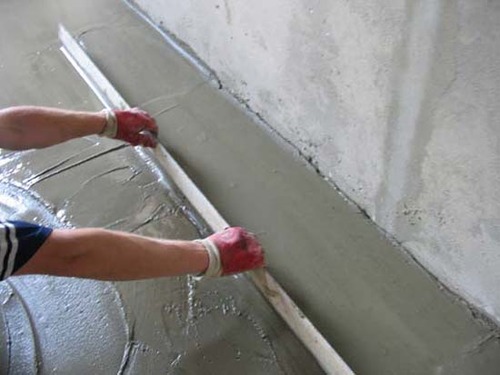
Preparatory work includes the replacement of damaged floorboards. Some boards can be flipped over to get a smoother, cleaner surface. Next, the surface is thoroughly cleaned, including from peeling paint. Heads of nails or self-tapping screws are sunk deeper so as not to damage the insulation. The gaps are filled with epoxy putty; assembly foam can be used on problem areas. Joints of the boards should preferably be treated with a sealant, which has a silicone or acrylic base. The prepared surface should be covered with a layer of moisture-resistant primer (as an option - waterproof paint).
Before pouring concrete on a wooden floor, you should stretch the plastic wrap without wrinkles so that the concrete and the substrate do not touch. Joints and possible suspicious places should be strengthened with duct tape so that a truly hermetic seal is obtained. The edges of the film to attach the stapler to the walls. The allowance over the edge of the planned tie is taken up to 5 cm.
Further, "beacons" (slats made of metal or wood) are put, along which the solution will be poured. The height of the screed must be at least 5 cm. It is good if the reinforcing mesh is additionally laid. Plasticizers should be added to the solution, which will both accelerate the acquisition of maximum strength and increase water resistance. If a self-leveling compound is used, strained threads can serve as beacons, although this method will be more expensive.
The room must be poured completely at one time, it is not allowed to fill parts. When laying should pierce the surface with a metal rod or a special needle roller so that the coating does not have air bubbles that impair strength. After pouring the prepared solution, the surface is ideally leveled with a rule or at least with a spatula.
Durability is gained only with time, therefore it is necessary to ensure proper drying. While the solution dries, periodically wet the surface with water (the first few days). Only after the solution has dried, you can take out the slats and prime, seal and wipe the voids with cement mixture. Next, the surface is once again wetted and covered with polyethylene for two weeks. After that, the allowances of polyethylene can be cut.
Before deciding to embed a concrete screed, you must ensure that the foundation can withstand a significant increase in load. You cannot make a new wooden floor covering: a new wooden floor may deform too much, which will damage the top surface.
And finally, we offer to see videos about leveling wooden floor.
